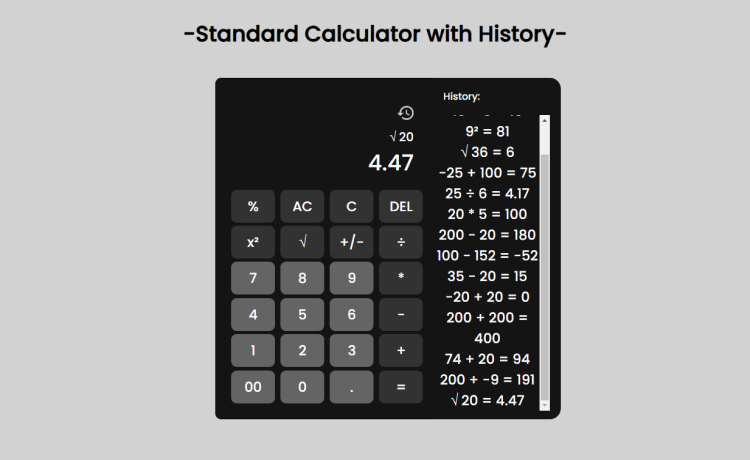Standard Calculator with History Using HTML, CSS and JavaScript with Source Code
In a world where digital tools have become indispensable, one of the most iconic applications remains the calculator. Whether it's simple arithmetic or complex calculations, a calculator is a trusty companion that helps us navigate the world of numbers. What if you could build your own standard calculator right in your web browser? Well, you're in luck!
In this article, we're going to take you on a journey of creating a standard calculator using the power of HTML, CSS, and JavaScript. It's a fantastic opportunity to explore the fusion of web technologies and learn practical development skills along the way.
We'll start with the user interface (UI) design, crafting a sleek and user-friendly calculator that you'd be proud to showcase. Then, we'll delve into the functionalities, from basic arithmetic operations to advanced features like square roots and history tracking.
You may also check simple HTML, CSS and JavaScript projects:
In this project, we will cover:
- HTML Structure: Building the skeleton of our calculator.
- CSS Styling: Designing an attractive and responsive user interface.
- JavaScript Logic: Implementing the calculation functionalities.
- Advanced Features: Adding square roots and history tracking.
- User Interaction: Ensuring smooth and intuitive user experiences.
Features:
-
Basic Arithmetic Operations:
- Addition (+)
- Subtraction (-)
- Multiplication (*)
- Division (/)
-
Clear and Delete Functionality:
- Clear Entry (CE): Clears the last input.
- Clear (C): Resets the calculator.
- Delete (DEL): Removes the last digit or character.
-
Square Root (√): Calculates the square root of a number.
-
Percentage (%): Calculates a percentage of a number.
-
Positive/Negative Toggle: Changes the sign of a number.
-
Decimal Point (.): Allows for decimal numbers.
-
History Tracking: Maintains a history of calculations, allowing users to review and reuse previous equations.
Sample Screenshots of the Project:
Standard Calculator Landing Page

Show History

How to Run?
- Download the provided source code zip file.
- Extract the downloaded zip file.
- Open the html file and you are now ready to go!
Conclusion
In conclusion, creating a Standard Calculator using HTML, CSS, and JavaScript is a rewarding project that combines web development skills with practical utility. By implementing a range of features, you can design a versatile calculator that meets the needs of users in various contexts.
Through this project, you've learned the importance of responsive design, user interface elements, and interactive functionalities. From basic arithmetic operations to advanced features like memory functions, square roots, and percentage calculations, you've built a calculator that empowers users to perform a wide range of computations with ease.
That's it! I hope this "Standard Calculator with History Using HTML, CSS and JavaScript" will assist you on your programming journey, providing value to your current and upcoming projects.
For additional tutorials and free source code, explore our websites.
Enjoyyy :>>
Note: Due to the size or complexity of this submission, the author has submitted it as a .zip file to shorten your download time. After downloading it, you will need a program like Winzip to decompress it.
Virus note: All files are scanned once-a-day by SourceCodester.com for viruses, but new viruses come out every day, so no prevention program can catch 100% of them.
FOR YOUR OWN SAFETY, PLEASE:
1. Re-scan downloaded files using your personal virus checker before using it.
2. NEVER, EVER run compiled files (.exe's, .ocx's, .dll's etc.)--only run source code.

